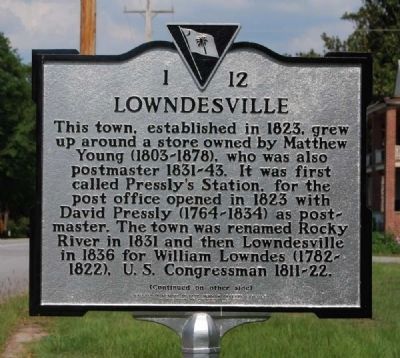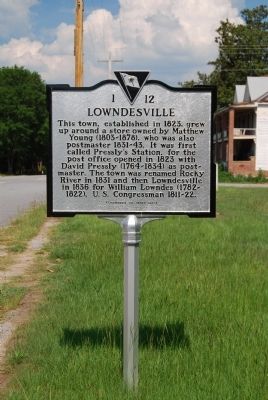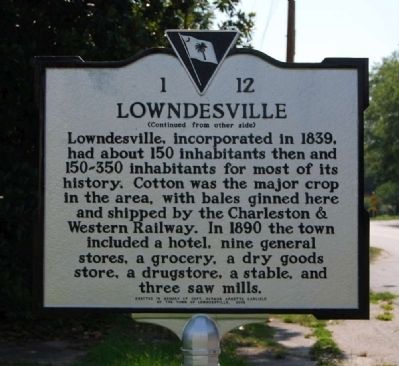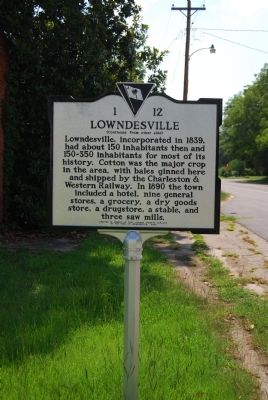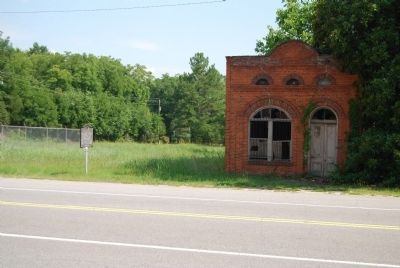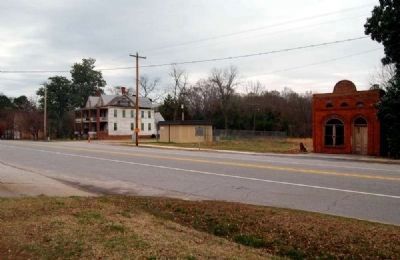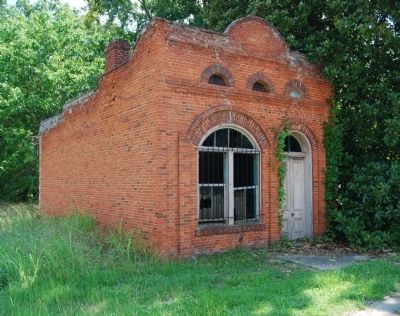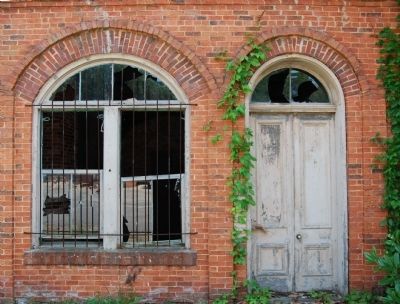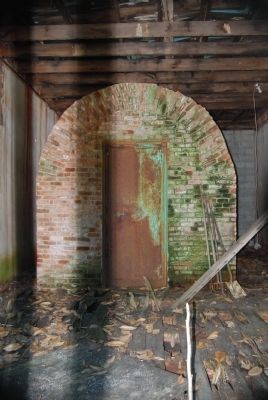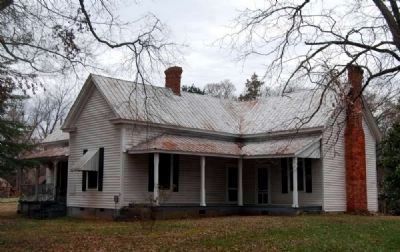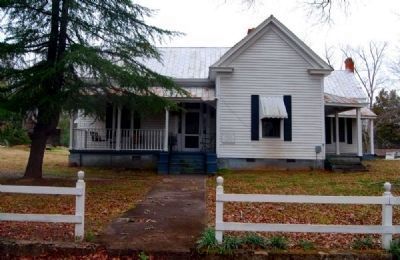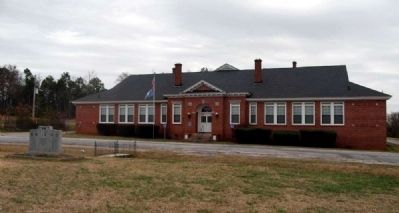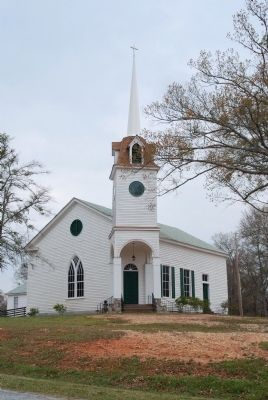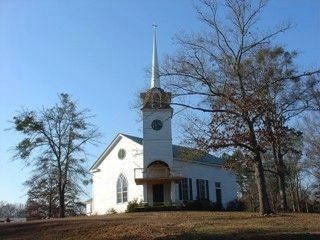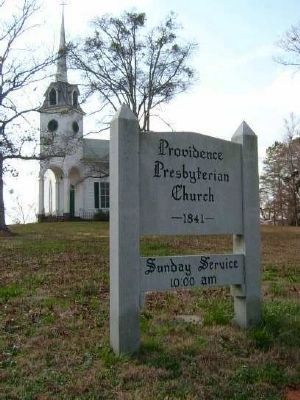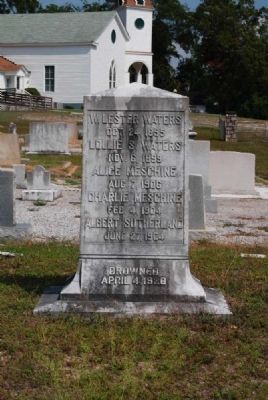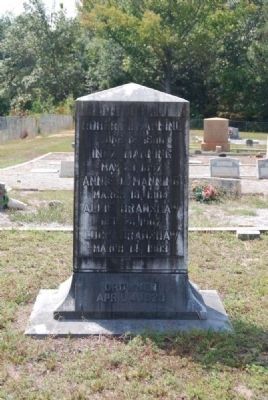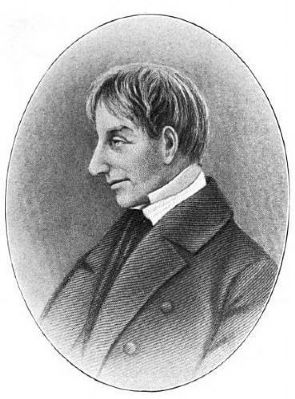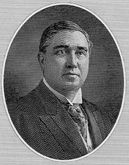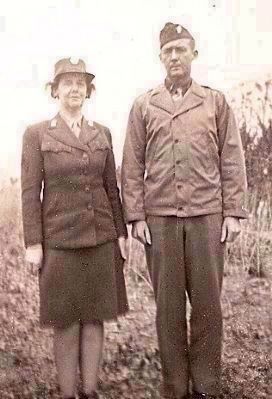Lowndesville in Abbeville County, South Carolina — The American South (South Atlantic)
Lowndesville
Lowndesville, incorporated in 1839, had about 150 inhabitants for most of its history. Cotton was the major crop in the area, with bales ginned here and shipped by the Charleston & Western Railway. In 1890 the town included a hotel, nine general stores, a grocery, a dry goods store, a drugstore, a stable, and three saw mills.
Erected 2006 by Town of Lowndesville in Memory of Capt. Herman Arnette Carlisle. (Marker Number 1-12.)
Topics. This historical marker is listed in these topic lists: Agriculture • Communications • Industry & Commerce • Settlements & Settlers. A significant historical year for this entry is 1823.
Location. 34° 12.627′ N, 82° 38.71′ W. Marker is in Lowndesville, South Carolina, in Abbeville County. Marker is on Main Street. Marker is located across the street from the Lowndesville Post Office and beside the old bank building. Touch for map. Marker is in this post office area: Lowndesville SC 29659, United States of America. Touch for directions.
Other nearby markers. At least 10 other markers are within 7 miles of this marker, measured as the crow flies. Lowndesville Veterans Monument (approx. 0.2 miles away); Harpers Ferry Drowning (approx. ¼ mile away); W.D. Nixon Bridge (approx. 0.8 miles away); Bartlett Tucker Family Cemetery (approx. 4 miles away); Battle of Cherokee Ford (approx. 6.1 miles away in Georgia); Good Hope Church (approx. 6½ miles away); Moffettsville / Moffettsville Postmaster Appointments (approx. 6.6 miles away); Old Iva Depot Mural (approx. 6.6 miles away); 1965 (approx. 6.7 miles away); Iva Veterans Monument (approx. 6.7 miles away). Touch for a list and map of all markers in Lowndesville.
Regarding Lowndesville. Lowndesville is nicknamed the "Town of Seven Hills." The selection of William Lowndes as the town's namesake was made at the request of Abbeville native Landgon Cheves.
In addition to Lowndes, Lowndesville was also the home of two other U.S. Representatives from Abbeville: Asbury Churchwell Latimer and Edward Cook Mann. Their biographies are below.
The town itself is in the shape of the letter "L" with points to the north and east. At the bend, on a hill overlooking the town, sits Providence Presbyterian Church, a striking white structure with a tall steeple. Behind the church is an old cemetery.
Also see . . .
1. Lowndesville. Lowndesville is a town in Abbeville County, South Carolina, United States. (Submitted on August 17, 2008, by Brian Scott of Anderson, South Carolina.)
2. William Lowndes. William Jones Lowndes (1782 – 1822) was an American lawyer, planter, and statesman from South Carolina who was the son of Rawlins Lowndes, an American Revolutionary War leader from South Carolina. (Submitted on August 22, 2008, by Brian Scott of Anderson, South Carolina.)
3. Edward Coke Mann. Edward Coke Mann (November 21, 1880–November 11, 1931) was a U.S. Representative from South Carolina. Born in Lowndesville, South Carolina, Mann attended the common schools and was graduated from The Citadel, Charleston, South Carolina, in 1901. (Submitted on August 22, 2008, by Brian Scott of Anderson, South Carolina.)
4. Charleston & Western Carolina Railway. In 1894, the South Carolina legislature forced the financially ailing Central of Georgia to give up its railroad properties in that state. (Submitted on December 26, 2008, by Brian Scott of Anderson, South Carolina.)
5. Asbury Latimer. Asbury Churchwell Latimer (July 31, 1851 - February 20, 1908) was a United States Representative and Senator from South Carolina. Born near Lowndesville, South Carolina, he attended the common schools, engaged in agricultural pursuits, and in 1880 moved to Belton, South Carolina and devoted his time to farming. (Submitted on October 6, 2010, by Brian Scott of Anderson, South Carolina.)
6. Langdon Cheves. Langdon Cheves (September 17, 1776 – June 26, 1857) was an American politician and a president of the Second Bank of the United States. It was Cheeves who suggested renaming his hometown of Rocky River Lowndesville, after Congressman William Lowndes. (Submitted on July 18, 2011, by Brian Scott of Anderson, South Carolina.)
Additional commentary.
1. William Lowndes (1782-1822)
William Lowndes, (brother of Thomas Lowndes), a Representative from South Carolina; born on “Horseshoe” plantation, near Jacksonborough, St. Bartholomew’s parish, South Carolina, February 11, 1782; pursued classical studies in England and at home; studied law; was admitted to the bar in 1804 and commenced practice in Charleston, S.C.; also engaged in agricultural pursuits; member of the State house of representatives 1804-1808; captain of militia in 1807; elected as a Republican to the Twelfth and to the five succeeding Congresses and served from March 4, 1811, until May 8, 1822, when he resigned; chairman, Committee on Ways and Means (Fourteenth and Fifteenth Congresses), Committee on Expenditures in the Department of the Treasury (Fifteenth Congress); nominated by the general assembly of South Carolina for the office of President of the United States in 1821; died at sea while en route to England October 27, 1822; remains were buried at sea. (Source: Biographical Directory of the U.S. Congress.)
William Lowndes was part of a short-lived but influential political dynasty. His father was Rawlins Lowndes, the 32nd Governor of South Carolina (March 6, 1778 – January 9, 1779). The elder Lowndes has been born on the island of St. Kitt, West Indies on January 6, 1721. His first political office was a provost marshall for South Carolina (1742-1752). He was first elected to the colonial legislature in 1749. During the Revolution, Lowndes was a strong supporter of the Revolution. He served in the First and Second Provincial Congresses and (after the war) the First and Second General Assemblies.
In 1778, Lowndes was elected President of South Carolina by the General Assembly (as the title of chief executive was known at the time). He quickly changed the title to governor and was the last person to use the title "president of South Carolina." He served one term and was reelected to the General Assembly where he remained until 1790. Lowndes was also intendant (mayor) of Charleston from September 1788 to September 1789. Lowndes died in 1790 and was buried in Charleston.
His two sons, the aforementioned William, and Thomas Lowndes, continued in politics. Thomas served in the state house of representatives from 1792-1799 and in the U.S. House of Representatives from March 4, 1801-March 3, 1805.
— Submitted July 21, 2009, by Brian Scott of Anderson, South Carolina.
2. Asbury Churchwell Latimer (1851-1908)
Asbury Churchwell Latimer, a Representative and a Senator from South Carolina; born near Lowndesville, Abbeville County, S.C., July 31, 1851; attended the common schools; engaged in agricultural pursuits; moved to Belton, Anderson County, S.C., in 1880 and devoted his time to farming; elected as a Democrat to the Fifty-third and to the four succeeding Congresses (March 4, 1893-March 3, 1903); did not seek renomination in 1902, having become a candidate for Senator; elected as a Democrat to the United States Senate and served from March 4, 1903, until his death; during his service in the Senate was appointed in 1907 a member of the United States Immigration Commission; died in Washington, D.C., February 20, 1908; interment in Belton Cemetery, Belton, S.C. (Source: Biographical Directory of the U.S. Congress.)
— Submitted July 21, 2009, by Brian Scott of Anderson, South Carolina.
3. Asbury Churchwell Latmer
Of South Carolina's representatives in national life and affairs a distinguished place is enjoyed by the late Asbury Churchwell Latimer, who entered Congress in 1892, served five successive terms, and was then chosen to a seat in the United States Senate. He did not complete the six years' term in the Senate, since death overtook his labors at Washington toward the close of the term. He died in the national city February 20, 1908.
The late Senator Latimer, whose home for many years was at Belton, where Mrs. Latimer still lives, was born in Abbeville County, near Lowndesville, July 31, 1851, son of Clement T. and Frances Beulah (Young) Latimer. His grandfather, Dr. James Latimer came from Charles County, Maryland, to South Carolina about 1800 and practiced medicine for many years in Abbeville County. Senator Latimer's father was a farmer and devoted his time to his farm interests until his death in 1876. His wife, who died in 1874, was also a native of Abbeville County and a daughter of a prominent farmer and citizen, William Young.
Asbury Churchwell Latimer grew up on his farm near Lowndesville, made good use of the opportunities of the common schools and the
Lowndesville Academy, and his youth and early manhood were spent in the period of the war and reconstruction, when the entire state suffered and so many normal opportunities were denied. He first took an active interest in politics in 1876, when the campaign for restoration of white government culminated in the triumph of the democratic party and the election of Wade Hampton. He was a member of the troops that took possession of the South Carolina State House at that time. Governor Hampton tendered him a position on his military staff. However, just at that time his father died and the pressing need for his services on the home farm obliged him to decline.
Senator Latimer removed to Belton in 1880. He always retained large and important farm interests, and was also active in business affairs. Several times he was chairman of democratic committees, but only reluctantly came into politics as a candidate. In 1800 he was urged by numerous friends to accept the nomination for lieutenant governor on the ticket headed by Ben R. Tillman. He declined this honor. In 1892 he was elected a member of Congress, and served continuously for ten years. In 1903 he was elected United States Senator and he served until his death, about a year before the end of his term.
Senator Latimer is remembered in South Carolina politics as a man of high principles, of sound views, an effective
student and worker, and his services were of a quality which entitle him to a high place among the state's public leaders. At the age of ten years he united with the Methodist Episcopal Church, South, and for many years was an official member of the church and also interested in Sunday school work.
June 26, 1877, he married Miss Sarah Alice Brown, daughter of the late William Carroll Brown, of Belton, whose life record is sketched elsewhere. Mr. and Mrs. Latimer had five children: William Carroll Latimer, an attorney at law of Atlanta, Georgia; Mamie Brown, who married Luther Martin Heard, of Elberton, Georgia; Anna Beulah, who married Grange S. Cuthbert, of Summerville, South Carolina; Olive Young, who married James H. Pallen, of Washington, District of Columbia; and Miss Sarah Alice Latimer. Mrs. Latimer, who lives at Belton, has traveled extensively, has been distinguished by an unusual ability in handling business affairs, is prominent in socal life, and for several years has given much of her personal attention to the management of her extensive farming interests. (Source: History of South Carolina, Vol III by Yates Snowden, pgs 169-170.)
— Submitted June 28, 2011, by Brian Scott of Anderson, South Carolina.
4. Edward Coke Mann (1880-1931)
Edward Coke Mann,
a Representative from South Carolina; born in Lowndesville, Abbeville County, S.C., November 21, 1880; attended the common schools and was graduated from The Citadel, Charleston, S.C., in 1901; taught school one year and was connected with a tobacco company for four years; was graduated from the law department of the University of South Carolina at Columbia in 1906 and commenced practice in St. Matthews, Calhoun County, S.C.; solicitor of the first circuit of South Carolina 1916-1919; elected as a Democrat to the Sixty-sixth Congress to fill the vacancy caused by the resignation of Asbury Francis Lever and served from October 7, 1919, to March 3, 1921; unsuccessful for renomination in 1920; practiced law in Orangeburg, S.C.; appointed master in equity for Orangeburg County in November 1923; reappointed in November 1927 and served until his death; was accidentally killed November 11, 1931, near Rowesville, S.C., while on a hunting trip; interment in Sunnyside Cemetery, Orangeburg, S.C. (Source: Biographical Directory of the U.S. Congress.)
— Submitted July 21, 2009, by Brian Scott of Anderson, South Carolina.
5. Hon. Edward Coke Mann
When after nearly twenty years of consecutive service the veteran Congressman A.F. Lever resigned his seat in August, 1919, as representative of
the Seventh South Carolina District, to take his place as a member of the Farm Loan Board, a special election was required to give the Seventh District its proper representation, and in that election, held October 7, 1919, the choice of the voters fell upon Edward Coke Mann, who at that time was solicitor of the First Circuit. Mr. Mann, who took his seat in Congress a few weeks after election, went to Washington possessed of the very highest qualifications for his responsibilities.
He is a lawyer by profession, and during his practice at St. Matthews has distinguished himself as a thinker and debater in public questions.
He was born at Lowndesville, Abbeville County, November 21, 1880, son of Rev. Coke D. and Eliza J. Mann. His father was for many years an active member of the South Carolina Methodist Conference, and the itinerant ministry required his residence in many towns of the state. In these towns Edward Coke Mann acquired his education, and later won a scholarship in Berkeley County at The Citadel at Charleston. He entered this famous military school in 1897 and graduated in 1901. The year following he taught school in Clarendon County, and for another four years was connected with the American Tobacco Company. In the meantime he took up the study of law and graduated LL. B. from the University of South Carolina in 1906. While in university he won the oratorical medal and represented the University in the State Conference and was state representative at the Southern Oratorical contest at Birmingham.
The first year he practiced at Darlington as a partner with Solicitor J. Monroe Spears, later was a member of the firm McLauchlin, Tatum & Mann at Bishopville, and upon the creation of Calhoun County in 1908 established his home and offices at St. Matthews. He gave all his time to his private clientage and to building up a sound reputation as an able lawyer until 1916, when he became a candidate for solicitor of the First Circuit and was elected. He made a splendid record as a prosecuting attorney for three years before he entered Congress.
Mr. Mann married Miss Mary McEachern, of Laurinburg, North Carolina, in 1908. Their one son, Edward, Jr., was born in 1911. (Source: History of South Carolina Vol IV by Yates Snowden, pg 298.)
— Submitted June 28, 2011, by Brian Scott of Anderson, South Carolina.
6. Langdon Cheeves (1776-1857)
Langdon Cheeves, a Representative from South Carolina; born September 17, 1776, in Bulltown Fort, near Rocky River, Ninety-sixth District (now Abbeville County), S.C., where the settlers had taken refuge from the onslaught of the Cherokee Indians; received his early education
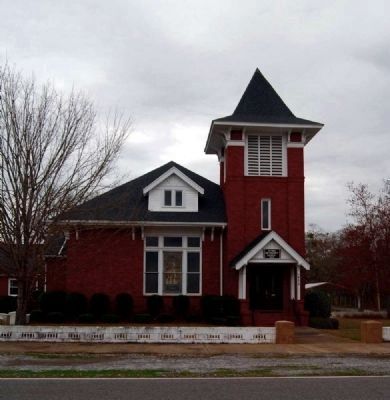
Photographed By Brian Scott, March 4, 2011
12. Smyrna Methodist Church (ca. 1808)
439 Main Street
439 Main Street
The church was originally known as Bowie Meeting House and located one mile north of where the town was erected. After moving a few times, the church found its home in 1917 at the corner of North Main and Depot Street.
of Ghent; resided in Philadelphia and Washington 1819-1826 and in Lancaster, Pa., 1826-1829; returned to South Carolina in 1829; engaged extensively in the cultivation of rice in South Carolina and Georgia; tendered an appointment by the Governor of South Carolina to the United States Senate to fill the vacancy caused by the death of John C. Calhoun, but declined; delegate to the Southern convention at Nashville, Tenn., in 1850 and to the State convention at Columbia, S.C., in 1852; died in Columbia, S.C., June 26, 1857; interment in Magnolia Cemetery, Charleston, S.C. (Source: Biographical Directory of the U.S. Congress.)
— Submitted July 18, 2011, by Brian Scott of Anderson, South Carolina.
7. The Fire of 1919
On February 14, 1919, Lowndesville was struck by a great fire which destroyed seven residences and nearly all of the business district. Most were never rebuilt and the town remained largely unchanged after the fire. Subsequent soil erosion and a destructive boil weevil invasion.
— Submitted July 18, 2011, by Brian Scott of Anderson, South Carolina.
8. Drowning at Harper's Ferry
Harper's Ferry crossed the Savannah River at Lowndesville. On April 4, 1920 (Easter Sunday),
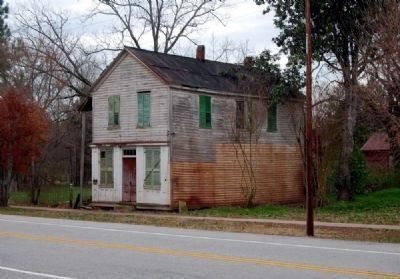
Photographed By Brian Scott, March 4, 2011
14. Roslin Masonic Lodge No. 86
The lodge in Lowndesville is one of the oldest in the state outside of Charleston. Its warrant was granted on June 4, 1852 to "John Brownlee, W.M., John C. Speer." This is one of the numerous offspring of Clinton Lodge No. 3 at Abbeville Courthouse. The lodge derives its name from the St. Clairs of Roslin, who were for many generations the hereditary Grand Masters of Scotland. The lodge met on the second floor; a general store, operated by Gordon Verdel, occupied the first floor.
The names is the deceased are:
Lollie S. Waters Nov 6, 1899
Alice Meschine Aug 7, 1906
Charlie Meschine Feb 4, 1904*
Albert Sutherland June 27, 1904
Robert Manning June 12, 1900
Inez Manning May 23, 1897
Annie Manning Mar 18, 1904
Allie Bradshaw Dec 28, 1907
Lucy Bradshaw May 14, 1903
* The body of Charlie Meschine was never found.
— Submitted July 18, 2011, by Brian Scott of Anderson, South Carolina.
9. Marker Style
The marker shown reflects the third style of South Carolina Historical Markers. It is currently in use and has been since 1996. The original design was cast aluminum and crowned with a bas relief of the state flag surrounded by an inverted triangle. The markers were painted silver with black lettering.
— Submitted September 16, 2008, by Brian Scott of Anderson, South Carolina.
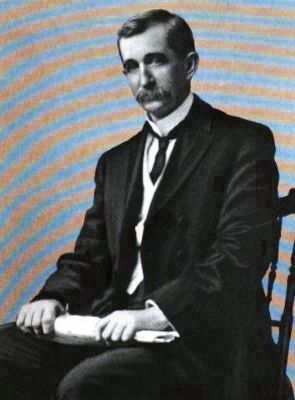
Men of Mark in South Carolina by James Calvin Hemphill
22. Benjamin Franklin Mauldin, Jr.
Founder and President of the
Lowndesville Banking Company
Founder and President of the
Lowndesville Banking Company
Benjamin Franklin Mauldin's father, Benjamin Sr., was a merchant, Baptist minister, and signer of the South Carolina Ordinance of Secession. Mauldin was president of the South Carolina Bankers Association and namesake of the City of Mauldin in nearby Greenville County. In addition to this bank, Mauldin founded and was president of banks in Anderson, Due West, McCormick, Hodges, Mt. Carmel, Trenton, and Townville.
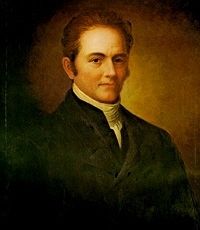
U.S. House of Representatives Collection, circa 1815
24. Langdon Cheeves
September 17, 1776 – June 26, 1857
September 17, 1776 – June 26, 1857
S.C. House of Rep 1802-1804, 1806-1808
Att Gen of S.C. 1808-1810
U.S. House of Rep from S.C. 1810-1815
9th Speaker of the House of Rep 1814-1815
Credits. This page was last revised on April 18, 2021. It was originally submitted on July 21, 2008, by Brian Scott of Anderson, South Carolina. This page has been viewed 10,027 times since then and 625 times this year. Photos: 1. submitted on July 21, 2009, by Brian Scott of Anderson, South Carolina. 2. submitted on July 21, 2008, by Brian Scott of Anderson, South Carolina. 3. submitted on July 21, 2009, by Brian Scott of Anderson, South Carolina. 4, 5. submitted on July 21, 2008, by Brian Scott of Anderson, South Carolina. 6. submitted on May 14, 2011, by Brian Scott of Anderson, South Carolina. 7, 8, 9. submitted on July 21, 2008, by Brian Scott of Anderson, South Carolina. 10. submitted on June 27, 2011, by Brian Scott of Anderson, South Carolina. 11. submitted on July 18, 2011, by Brian Scott of Anderson, South Carolina. 12, 13. submitted on June 28, 2011, by Brian Scott of Anderson, South Carolina. 14. submitted on July 18, 2011, by Brian Scott of Anderson, South Carolina. 15. submitted on July 21, 2008, by Brian Scott of Anderson, South Carolina. 16, 17. submitted on July 18, 2011, by Brian Scott of Anderson, South Carolina. 18, 19. submitted on October 12, 2011, by Brian Scott of Anderson, South Carolina. 20. submitted on June 28, 2011, by Brian Scott of Anderson, South Carolina. 21. submitted on October 6, 2010, by Brian Scott of Anderson, South Carolina. 22. submitted on July 29, 2009, by Brian Scott of Anderson, South Carolina. 23. submitted on June 28, 2011, by Brian Scott of Anderson, South Carolina. 24. submitted on July 18, 2011, by Brian Scott of Anderson, South Carolina. • Christopher Busta-Peck was the editor who published this page.
